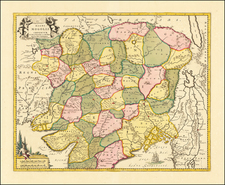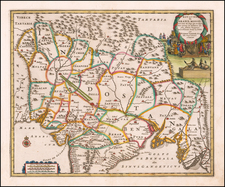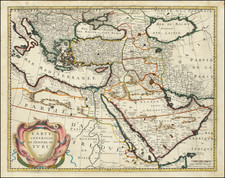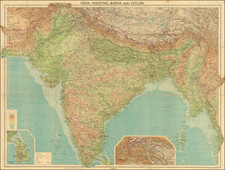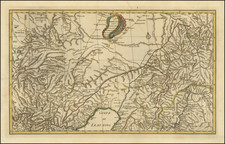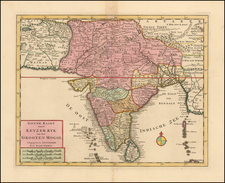The Grand Lama: Lobsang Gyatso, the Fifth Dalai Lama
Interesting engraved image of the Grand Lama, from Mallet's Description de L'Univers, first issued in Paris in 1683.
In 1683, the title of the "Grand Lama" or, more commonly known, the Dalai Lama, was held by Lobsang Gyatso, the Fifth Dalai Lama. His reign was one of the most influential and transformational in the history of Tibet. A spiritual leader and a statesman, Lobsang Gyatso played a pivotal role in consolidating the political and spiritual influence of the Gelugpa school of Tibetan Buddhism and establishing the Dalai Lamas as both the temporal and spiritual rulers of Tibet.
Lobsang Gyatso was born in 1617 in Chonggye, Tibet. Recognized at an early age as the reincarnation of the Fourth Dalai Lama, he was enthroned at the Drepung Monastery when he was just five. As he grew, he received rigorous monastic training, mastering Buddhist philosophy and practices. He studied under several great lamas of the time, which laid a robust foundation for his spiritual leadership.
One of the Fifth Dalai Lama’s most enduring achievements was the construction of the Potala Palace in Lhasa. This magnificent architectural marvel remains one of the most iconic structures in Tibet, symbolizing the fusion of spiritual and temporal power. It would become the winter residence of the Dalai Lamas and an essential place for Tibetan religious, cultural, and administrative functions.
In terms of political consolidation, the Fifth Dalai Lama's reign witnessed the reunification of Tibet. With the assistance of the Mongol chieftain Gushri Khan, Lobsang Gyatso subdued rival Tibetan schools and principalities, bringing the entire region under the centralized rule of the Gelugpa school and effectively becoming the temporal ruler of Tibet.
Furthermore, the Fifth Dalai Lama forged ties beyond Tibet's borders, establishing relations with China's Qing dynasty. His visit to Beijing in 1653 to meet the Qing Emperor Shunzhi not only strengthened Tibetan-Chinese relations but also enhanced the stature and international legitimacy of the Dalai Lama institution.
On the spiritual front, Lobsang Gyatso penned numerous works, providing fresh insights into Tibetan Buddhist practices. His writings and teachings continue to be an integral part of Gelugpa studies and serve as a guiding light for followers.
Alain Mannesson Mallet (1630-1706) was a French mapmaker and engineer who served in the armies of Louis XIV. After rising through the ranks, Mallet was appointed as Inspector of Fortifications, a job which also required mathematical skills and which made him a competent military engineer. Eventually, he joined the court of Louis XIV at Versailles, where he taught math and focused on writing.
Mallet is best known for his Description de L’Univers, first published in 1683, in five volumes. A wide-ranging geographical work, the Description included textual descriptions of the countries of the world, as well as maps of the celestial sky and the ancient and modern worlds. The Description continued to be published until the early eighteenth century. He also published a work in three volumes on warfare (1684) and a primer on geometry (1702).









